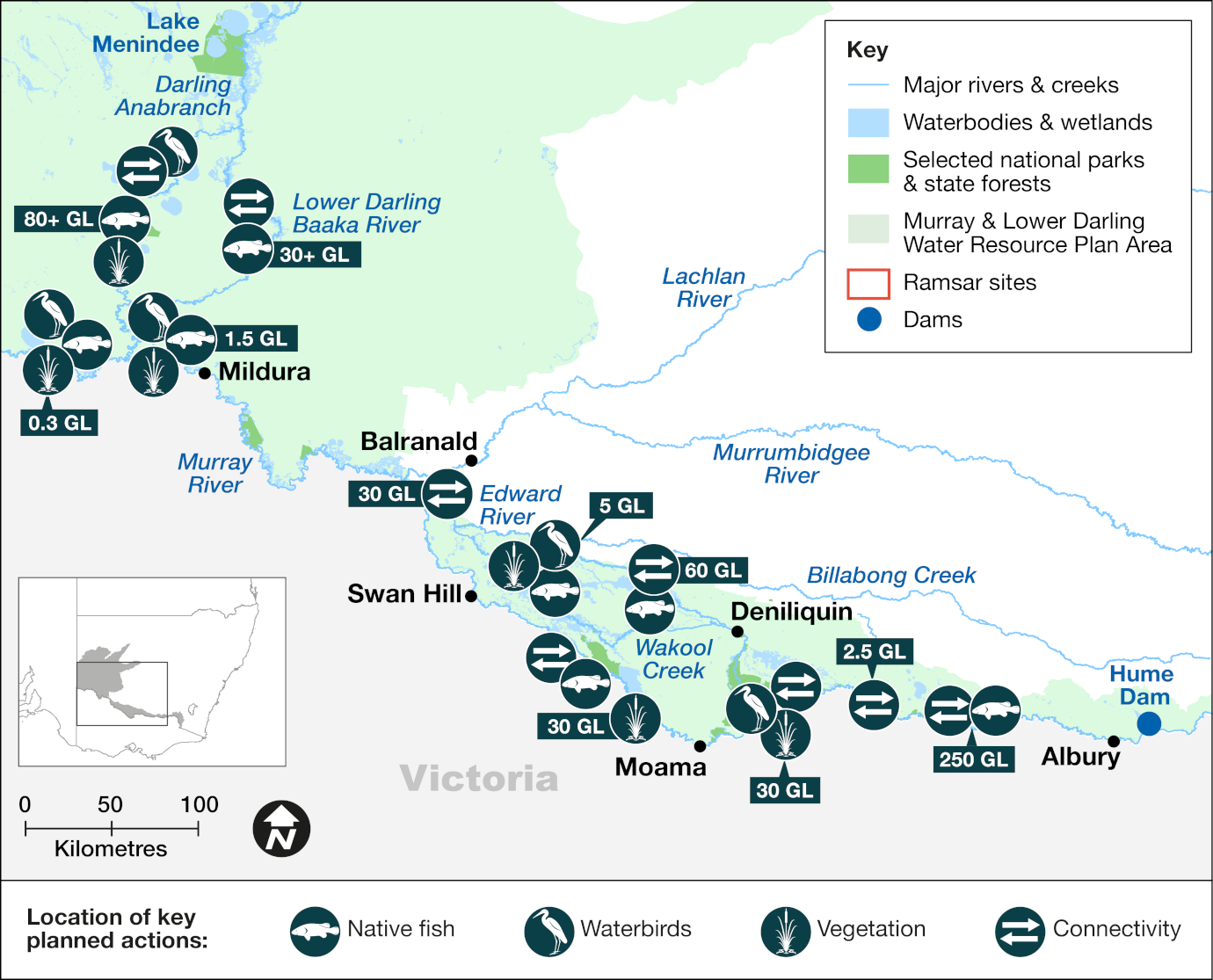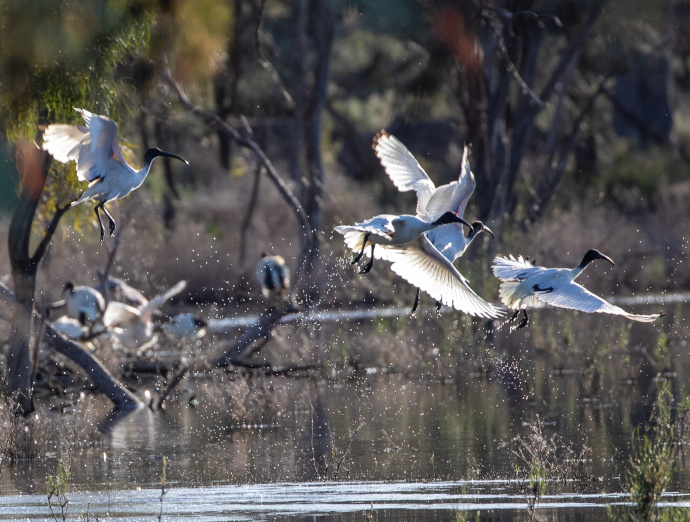Water that is allocated and managed specifically to improve the health of rivers, wetlands and floodplains is known as water for the environment.
Our environmental water management teams work with local community advisory groups including landholders, Aboriginal stakeholders, partner agencies and other interested community members to develop detailed annual plans for the use of water for the environment in each catchment, including how its use is prioritised.
Water for rivers and wetlands
In 2024–25, managed environmental flows will target a range of outcomes, including:
- watering regimes that support the nationally threatened Australasian bittern and southern bell frog
- improved conditions for small-bodied native fish
- connectivity, refuge and dispersal flow for large-bodied native fish
- support for floodplain ecosystems, including the Central Murray Forest Ramsar site, which includes the Millewa, Werai and Koondrook-Perricoota forests.
Wet conditions prevailed in the Murray River system from 2023 to 2024. Rainfall in the upper catchments produced 2 moderately sized, unregulated events in the Murray River downstream from Yarrawonga Weir in July and October 2023.
Following the October event, water for the environment supported native fish populations in the Murray River during the flow recession and maintained optimal nesting conditions for waterbirds at key sites. Water for the environment was managed in the Baaka – Lower Darling River and Darling Anabranch to support the migration of native fish to the Murray River and water quality risk-mitigation efforts. Under an adaptive plan, water managers worked with other agencies and the community to coordinate the delivery of releases and to monitor, assess, and manage risks.
Partnering with Aboriginal peoples

Water for Country is environmental water use planned by the Department of Climate Change, Energy, the Environment and Water (the department) and Aboriginal people to achieve shared benefits for the environment and cultural places, values and/ or interests.
The Murray and Baaka – Lower Darling includes the Murray, Edward, Wakool and Niemur river systems, the Central Murray Forest Ramsar site, the Baaka – Lower Darling and Darling Anabranch, and numerous other sites.
In 2024–25, the department will engage Aboriginal groups across these areas by working with Aboriginal peoples, Aboriginal organisations and Aboriginal environmental water advisory group representatives. This will guide environmental water managers on how to deliver water into floodplains, wetlands and waterways for co-environmental and cultural outcomes.
Weather and water forecast
As of June 2024, the El Niño–Southern Oscillation outlook is neutral. That is, neither La Niña nor El Niño conditions are favoured as oceanic and atmospheric indicators have returned to neutral levels.
International climate models suggest neutral El Niño–Southern Oscillation conditions will persist through the southern winter, but there are some signs that La Niña conditions could form later in the 2024–25 water year. Water managers have prepared watering plans that consider a range of weather and water availability scenarios. This is known as resource availability scenario planning.
Resource availability scenario
This table provides details about how we plan for different resource availability scenarios. Moderate conditions are forecast for the Murray and Baaka – Lower Darling catchments in 2024–25, which means water availability planning will follow the ‘moderate’ scenario.
|
|
Very dryMain aim: protect - avoid critical loss |
DryMain aim: maintain - maintain river functioning |
|
Current forecast |
ModerateMain aim: recover - improve ecological health and resilience |
|
|
Wet to very wetMain aim: Enhance |
Key planned actions
Native fish
Murray River multi-site flows are planned from Hume Dam to South Australia to support native fish and instream productivity. This is a collaboration between New South Wales, Victorian and South Australian governments and agencies.
Fish flows in the Edward–Wakool system will provide benefits for native fisheries, instream vegetation and food webs.
A winter-spring flow is planned for the Baaka – Lower Darling River to support native fish population recovery and recruitment. There may be potential for a flow down the Great Darling Anabranch to the Murray River, water volumes permitting.
Waterbirds
Watering events are planned for the Murray catchment national and regional parks to support sites that contain nesting Australasian bitterns and other native waterbirds. Australasian bitterns are an important story-telling species for Aboriginal people.
Water for the environment will be delivered to sites including Lake Agnes to promote waterbird breeding for threatened species such as the blue-billed duck.
Fish flows in the Edward–Wakool system will provide benefits for native fisheries, instream vegetation and food webs.
A winter-spring flow is planned for the Baaka – Lower Darling River to support native fish population recovery and recruitment. There may be potential for a flow down the Great Darling Anabranch to the Murray River, water volumes permitting.
Vegetation
Flows will be delivered to private wetlands, providing critical habitat for southern bell frogs and promoting vegetation and other wildlife. Supporting the condition of remnant woodlands and other floodplain vegetation communities produces essential carbon and nutrients to support the aquatic food web and provides habitat and corridors for wildlife, such as the nationally threatened superb parrot. Water for the environment will be used to expand areas of common reed (Phragmites australis) in the Central Murray Forest Ramsar site during spring 2024.
Connectivity
Water for the environment will inundate as much area as possible of the Central Murray Forest Ramsar site during spring 2024 and provide return flows to the Murray, Edward, Niemur and Wakool rivers. Flows will provide connectivity between the Edward, Niemur and Wakool rivers and Tuppal, Cunninyeuk, Murrain Yarrein, Cockran–Jimaringle, and Yarrein creeks.
Map of proposed annual priority targets in the water resource plan area 2024–25



